48. Low-Code/No-Code Platforms – Democratizing AI Development in Retail
In the retail industry, technology has always been a double-edged sword. On one side, advanced AI and analytics promise to turbocharge customer engagement and operational efficiency. On the other, developing such capabilities has traditionally been expensive and complex – a luxury that only major retail corporations could afford. But what if the power of AI could be democratized, handed over to every retail business regardless of size or budget? This is no longer a hypothetical; it’s happening today thanks to the rise of Low-Code/No-Code platforms. These tools are fundamentally reshaping how AI solutions are built and deployed, leveling the playing field between nimble SMBs and giant enterprises. In this article, we’ll explore how low-code and no-code (LCNC) platforms are transforming AI development for small and mid-sized retailers. We’ll examine why this trend is picking up steam, how it empowers retail organizations to innovate faster, and what decision-makers need to know to leverage it effectively. By the end, one thing will be clear: embracing low-code/no-code AI isn’t just a tech decision – it’s a strategic business move that could define the future of retail success.
Q1: FOUNDATIONS OF AI IN SME MANAGEMENT - CHAPTER 2 (DAYS 32–59): DATA & TECH READINESS
Gary Stoyanov PhD
2/17/202517 min read

1. The AI Imperative for SMB Retailers
Retail has become a technology-driven game, and AI sits at the heart of today’s most exciting retail innovations. Personalization engines recommend products uniquely tailored to each shopper. Demand forecasting models fine-tune inventory so shelves are stocked with just what customers want. Computer vision monitors store traffic and prevents losses. For large retailers, deploying these AI solutions has become second nature, supported by sizable IT teams and budgets.
SMB retailers, however, often find themselves on the outside looking in. They face a familiar trio of challenges: limited budgets, a shortage of in-house tech talent, and off-the-shelf software that doesn’t quite fit their niche needs. Traditional AI development can be resource-prohibitive. Hiring data scientists or machine learning engineers is costly, and their time is at a premium. Engaging third-party developers or consultants might yield results, but it’s slow and can rack up bills that strain an SMB’s finances. Meanwhile, doing nothing isn’t an option – not if you aim to stay competitive. In an era where customer expectations are sky-high (think same-day delivery, highly curated product suggestions, instant support), lagging in innovation can be a fatal mistake.
Enter the concept of democratizing AI development. This is the idea that creating AI-driven applications shouldn’t be the exclusive domain of tech wizards or Fortune 500 companies. Just as the internet and smartphones leveled the playing field for marketing and commerce, new approaches in software development are poised to empower smaller players to build their own intelligent tools. And at the forefront of that movement are Low-Code and No-Code platforms.
2. What Are Low-Code/No-Code Platforms? (And Why AI Development is No Longer Just for Programmers)
Low-Code/No-Code platforms are software development environments that allow people with little to no traditional coding experience to create applications through graphical interfaces and pre-built components. If traditional coding is writing a novel from scratch, low-code is more like filling in the blanks of a very detailed story template, and no-code is choosing your own adventure with prompts guiding you every step of the way. These platforms handle the heavy lifting (the complex code behind the scenes), so users can focus on design and functionality at a higher level.
No-Code means you can build applications without writing any code at all. Users manipulate elements through drag-and-drop interfaces, form wizards, and visual process designers. It’s akin to using a WYSIWYG website builder – the technical complexity is abstracted away.
Low-Code might involve a bit of scripting or logic configuration, but far less than hand-coding an entire app. It’s targeted at people who are somewhat tech-savvy (think power users or business analysts), enabling them to tweak or extend applications beyond what pure no-code allows.
Crucially, modern LCNC platforms have evolved to support AI and machine learning functionalities. This includes integrations or built-in modules for things like data visualization, predictive modeling, chatbot creation, and connecting to AI services (like an image recognition API or an AutoML service). For example, there are no-code tools today that let you train a custom machine learning model by uploading data and clicking through a few configurations – no Python or R programming required.
For SMB retailers, this means tasks that once required a dedicated software team can potentially be handled by an existing employee or a small cross-functional group. A marketing manager could set up a recommendation engine; an operations officer might create a dashboard that uses AI to predict stock outages. It’s the concept of the “citizen developer” in action – non-developers building valuable software solutions. And this citizen developer movement is gaining serious traction across industries.
In fact, Gartner predicts that by 2025, 70% of new applications developed by enterprises will use low-code or no-code technologies, a huge leap from less than 25% in 2020. While that statistic focuses on enterprises, the implication for smaller businesses is clear: LCNC is rapidly becoming a mainstream approach to building software.
3. How Low-Code/No-Code Democratizes AI Development
“Democratization” isn’t just a buzzword here – it captures the heart of what’s changing. Low-code and no-code platforms make AI development accessible to those who traditionally lacked access: namely, businesses without big tech teams and individuals without programming degrees. Here’s how this democratization unfolds:
Accessibility to Non-Tech Experts: The obvious shift is that more people can contribute to development. In a retail context, your store managers, marketing staff, or operations analysts – people who deeply understand specific problems – can now be directly involved in crafting AI solutions to address those problems. They don’t have to translate their needs to a distant IT team and hope nothing is lost in translation; they can prototype the solution themselves. This “internal crowdsourcing” of innovation means great ideas from the front lines see the light of day faster.
Faster Development Cycles: With pre-built modules and templates, developing an AI-infused app can go from a multi-month project to a multi-week or even multi-day project. For example, if you want to analyze customer purchasing patterns, a low-code platform might offer a ready-made data pipeline and analytics dashboard template. Just connect your data, tweak a few settings, and you have a functional solution. This speed is crucial for SMBs in retail, who must be agile to compete. When a new trend emerges or a crisis hits (like a sudden supply chain disruption), being able to spin up a relevant tool quickly can make a big difference.
Cost Reduction: Hiring software developers or purchasing enterprise software licenses can be prohibitively expensive for SMBs. Low-code platforms often operate on subscription models that are far more affordable, and because they allow existing employees to do the work, you save on labor costs too. One set of statistics noted that low-code development projects can cut development time by 50-90% compared to traditional methods, which directly translates into cost savings. Moreover, you don’t need to maintain a large IT staff to keep these apps running – many low-code solutions are cloud-based and handle maintenance and updates for you.
Empowering “Domain Experts”: In retail, context is king. The folks in the field often know the pain points intimately and have creative ideas to solve them. Low-code gives these domain experts a direct way to test their ideas. For instance, your inventory supervisor might realize that certain products consistently run low before reorders kick in. Instead of filing a request and waiting in the IT queue, they could use a no-code tool to set up an automated alert system or even a simple predictive model that flags potential stockouts. The people with hands-on business knowledge drive the innovation, which often leads to more practical and immediately useful outcomes.
Leveling the Playing Field: Perhaps the most profound impact is the competitive equalizer effect. When advanced capabilities like AI-driven apps or custom analytics are no longer exclusive to those with deep pockets, smaller retailers can match or even outmaneuver larger competitors in certain areas. As one tech entrepreneur put it, this shift “levels the playing field, empowering SMBs to compete with larger corporations and unlock new opportunities for growth”. A boutique retailer can offer an app experience nearly as personalized and sophisticated as a big chain’s, blurring the lines of perceived professionalism and tech savviness in the eyes of consumers.
In essence, low-code/no-code platforms take the power that was concentrated in the hands of a few (developers and IT giants) and distribute it among the many – much like how the advent of personal computing spread computing power to the masses. It’s a transformative shift: AI for all, not just for the privileged few.
4. Benefits of Low-Code/No-Code for Retail Businesses
Let’s drill down into the specific benefits that an SMB in retail can expect from embracing low-code/no-code development, especially for AI and automation projects:
🚀 Speed to Market: Develop and deploy new apps or features in days or weeks, not months. This agility means you can respond faster to market changes or internal business needs. Whether it’s launching a flash sale management tool or a quick chatbot for a seasonal campaign, being first can be a big advantage.
💰 Lower Development Costs: With fewer specialized programmers needed, your development costs drop. One person can do the job that might have required a small team before. And that one person could well be someone already on your payroll wearing a new hat. The cost savings extend beyond salaries – consider the reduction in expensive mistakes thanks to tested templates, and savings on traditional IDEs, servers, etc., since many low-code tools are cloud-based.
🤝 Closer Business-IT Alignment: Because the people who use the system can build the system, there’s far less gap between requirements and outcome. No lengthy back-and-forth to explain retail jargon or processes to an outside developer. The result is solutions that fit like a glove, because they were created by the wearers of the glove.
🎯 Focus on Innovation Over Infrastructure: Low-code platforms handle a lot of the boring stuff – like scalability, security patches, cross-platform compatibility. This frees your time to focus on the innovative aspects of a project. Want to try a new promotion algorithm? You can concentrate on the logic of promotions, not setting up databases and servers.
📈 Scalability and Flexibility: Many LCNC platforms run on robust cloud infrastructure. If your application suddenly needs to scale (e.g., your new mobile app for customers goes viral and thousands of users hop on), the platform often scales automatically. You also gain flexibility to integrate with other systems via APIs or connectors provided out-of-the-box. For instance, connecting your no-code app to a Shopify store or a Google Analytics account is often just a few clicks.
🛡️ Reduced Risk with Governance Tools: Mature low-code platforms haven’t ignored the need for oversight. They often come with admin consoles where your IT or leadership can set permissions, monitor usage, and enforce compliance. This means you can decentralize innovation while still maintaining overall control and security.
📊 Data-Driven Decision Making: By making it easier to build analytics dashboards or AI models, low-code platforms encourage a data-first culture. Employees are more likely to build a quick report or set up an A/B test when it’s this accessible. Over time, you get a workforce that instinctively uses data and even AI insights in their daily decisions – because the tools to do so are at their fingertips.
In short, low-code/no-code platforms can supercharge a retail SMB’s digital transformation efforts. They bring speed, cost-efficiency, and a collaborative spirit to what used to be a slow, expensive, siloed endeavor. It’s worth noting that this isn’t just theory – the adoption numbers speak volumes. A recent survey found that 94% of companies across various industries had adopted low-code solutions by 2022, and the retail sector is a big part of that wave. Those who leverage these benefits sooner will ride the crest of innovation; those who don’t may find themselves swimming upstream later on.
5. Use Cases: How Retail SMBs Are Leveraging Low-Code/No-Code AI
It’s all well and good to talk about benefits in abstract, but what do these platforms actually enable retailers to do? Here are some concrete use cases where low-code/no-code platforms can make a transformative impact on retail operations and customer experience:
5.1 Personalized Marketing Campaigns
Small retailers can harness AI to segment customers and personalize outreach without a data science team. For example, using a no-code marketing automation tool with AI capabilities, a boutique could create customer segments (VIPs, bargain hunters, trend seekers) based on purchase history and engagement. Then, they could automatically send tailored promotions or product recommendations to each segment. A process that might have required a marketing analyst and a programmer to collaborate in the past can now be largely handled within a single platform by the marketing lead. The result? Higher conversion rates and customer loyalty driven by personalization, accomplished with minimal fuss.
5.2 Inventory Management and Demand Forecasting
Inventory woes – too much of what doesn’t sell, not enough of what does – plague retailers of all sizes. Low-code platforms can help build custom inventory management apps that hook into sales systems, track stock levels in real-time, and use embedded AI to forecast demand. Imagine a drag-and-drop dashboard that highlights items at risk of stockout and even suggests optimal reorder quantities based on trends. One no-code use case is setting up an app that sends a text alert to the store manager when a product’s inventory falls below a threshold and predicts how many days until it’s gone. These are smart, tailored systems that an SMB could create without waiting months or paying through the nose for an enterprise solution. As a bonus, since you’re building it, you can tweak the logic anytime (say, before a holiday season) without calling in a developer.
5.3 Customer Service Chatbots
Providing 24/7 customer service is tough for a small business. Chatbots powered by AI can fill that gap, but developing a chatbot with natural language understanding typically requires AI expertise. Enter no-code bot builders. Platforms now allow you to design a chatbot conversation flow with a visual editor, define likely customer questions, and integrate an AI service for language understanding – all via configuration, not coding. A small retail website could have an intelligent FAQ bot up and running in a day. It might handle queries like “Where’s my order?” or “Do you have product X in size Y?” and seamlessly hand off to a human if it can’t help. The payoff is improved customer satisfaction (instant answers at 11 PM!) and reduced workload on your staff.
5.4 Process Automation (RPA) in the Back Office
Retail isn’t just customer-facing glamour; there are tons of back-office processes ripe for automation. Maybe it’s reconciling online orders with inventory every night, or generating purchase orders when stock runs low, or consolidating sales from multiple channels into one report. Low-code platforms often include workflow automation or RPA (Robotic Process Automation) features that let you sequence tasks and integrate systems through a visual interface. You could, for instance, automate the entire purchase order process: when inventory hits a trigger point, the system creates a draft PO, emails it to the supplier, and notifies your finance team – all without anyone writing a script. By automating repetitive tasks, your team can focus on higher-value work (like interacting with customers or planning growth strategies).
5.5 Custom Retail Analytics Dashboards
Data is only as good as the insights you can extract. Many small retailers export data to spreadsheets for analysis, which is manual and limited. With low-code tools, you can build your own analytics dashboards that pull data from multiple sources (point-of-sale systems, e-commerce site, social media metrics, etc.) into one view. Even better, you can incorporate AI to highlight anomalies or opportunities (for example, a spike in interest for a product trending on TikTok might be flagged by an AI module looking at social data). These dashboards can be built by a savvy manager using templates and connectors provided by the platform, giving your team real-time insight without needing a full BI (Business Intelligence) software rollout.
Each of these use cases shares a theme: tailoring and integrating AI-driven capabilities in a way that off-the-shelf software often can’t match for a specific business. Low-code/no-code platforms give SMB retailers the flexibility to create exactly what they need, when they need it. And the beauty is that these aren’t just ideas – many retailers have already done these or similar projects with great success, often with guidance from consultants who specialize in low-code implementation for business.
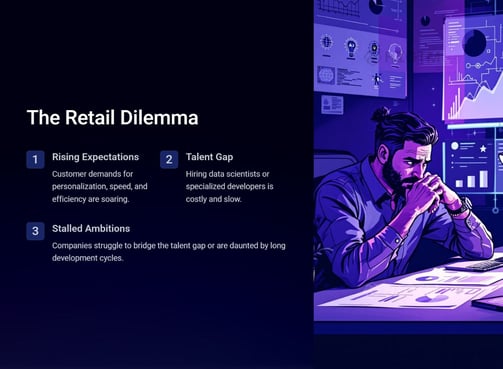

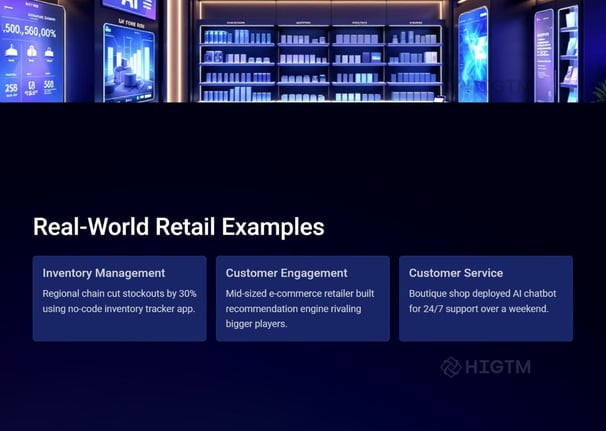

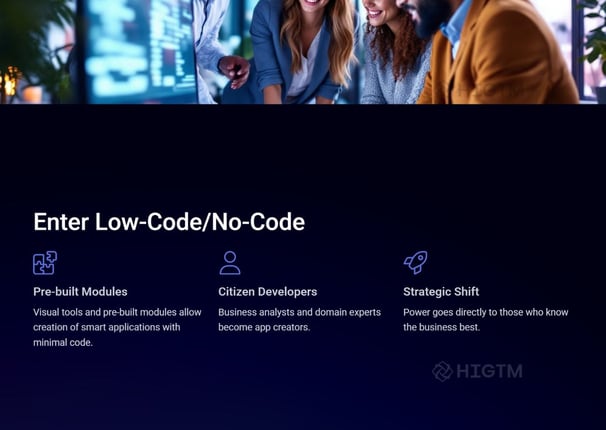

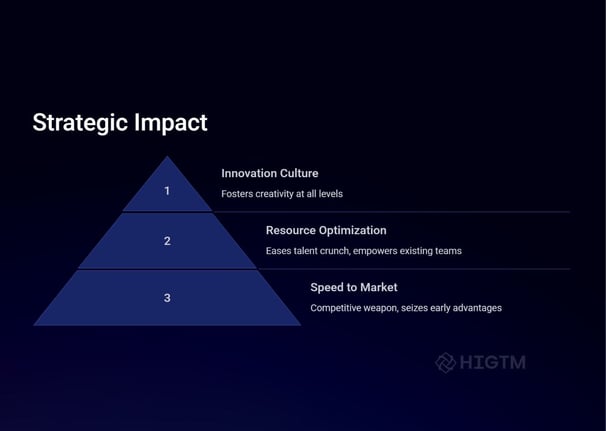

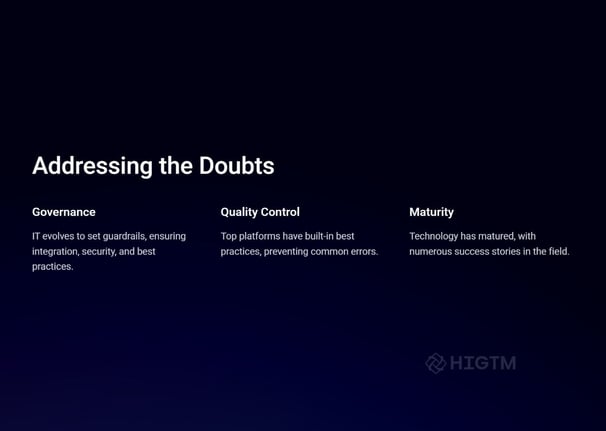

6. Overcoming Challenges and Ensuring Success
It’s important to acknowledge that adopting low-code/no-code approaches isn’t a magic wand. There are challenges and pitfalls to be aware of, and success comes from navigating them thoughtfully:
6.1 Platform Selection
With the surge in popularity, the market is crowded with low-code/no-code platform options. Some are general-purpose, while others specialize (some are great for simple forms and workflows, others excel in embedding AI or IoT integration). Retailers should carefully evaluate platforms for fit. Key factors include: ease of use, scalability, security features, ability to integrate with your existing systems (ERP, POS, CRM, etc.), and cost. It might be wise to start with one of the major players that have a robust community and support – such as Microsoft’s Power Platform, Google’s AppSheet/Looker Studio, or out-of-the-box AI services like AWS Honeycode or Salesforce’s low-code offerings – or consult with an expert who knows the landscape.
6.2 Training and Change Management
If you want your team to adopt these tools, invest in some training and time for experimentation. The concept of being a “citizen developer” is new to many employees. There can be an initial intimidation factor – “I’m not a developer, can I really build an app?” The good news is that these tools are designed to be learned quickly; still, encouragement and empowerment from leadership are key. Consider running a workshop or hackathon internally to kickstart creativity. Also, recognize and reward early adopters on your team who create successful apps – they will become champions who inspire others.
6.3 Governance and Oversight
As mentioned earlier, giving everyone the keys to create apps requires some guardrails. Establish governance early on. This might involve: setting up a review process for new apps (to ensure quality and security standards), maintaining documentation of what’s being built, and controlling access to sensitive data. You don’t want 10 different pricing apps all doing the same thing in silos, or an app inadvertently exposing customer data because it wasn’t configured securely. A good practice is to form a “low-code council” – a small group that includes IT representatives and business users – to oversee projects, share best practices, and prevent sprawl or duplication.
6.4 Avoiding the “Shadow IT” Trap
One criticism often levied at the citizen development trend is the risk of “shadow IT” – systems built without formal approval that can become critical without proper support. To avoid this, integrate LCNC development into your IT strategy. Even if business users are building, loop in your IT department on what’s being built. This ensures apps can be supported and maintained long-term, and if a key employee leaves, you’re not left with an enigma of an app that no one else understands. Many low-code platforms store app configurations in a way that’s easier for others to pick up, but having a plan for maintenance is still important.
6.5 Knowing When to Code
Low-code and no-code are powerful, but they’re not the answer to every tech problem. There may be complex scenarios or highly specialized needs where custom coding or traditional development is more appropriate. Part of a successful strategy is recognizing the limits. Use low-code for what it’s best at – rapid, iterative, moderately complex applications and automations. If you hit a wall or need something truly novel that the platform can’t support, that’s okay. Low-code can often still accelerate a portion of the work (maybe prototyping or handling routine parts) and you can bring in developers for the rest.
By anticipating these challenges, SMBs can approach low-code/no-code adoption with eyes wide open and maximize their chances of success. It’s about blending the freedom of these platforms with responsible management. When done right, you get an organization that is both highly innovative and well-governed.
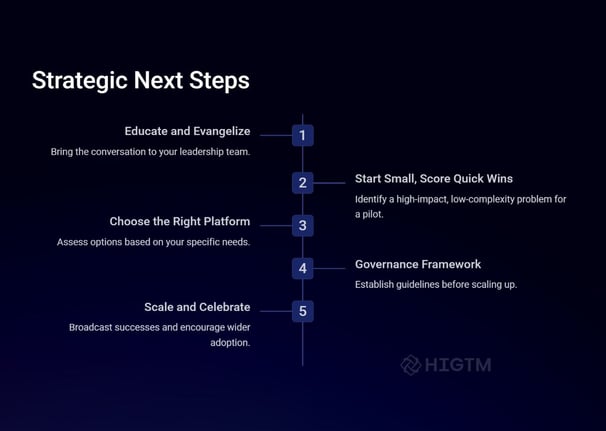

7. Getting Started: A Roadmap for Retail SMBs
Embracing low-code/no-code development in your retail business can feel like a big leap. But with a step-by-step approach, it becomes an exciting journey rather than a daunting jump. Here’s a simple roadmap to get you started:
Identify High-Impact Areas: Begin by listing out pain points or wish-list projects in your business. Focus on things that are important but have been sidelined due to lack of resources. For instance, “We spend too much time manually updating online inventory” or “I wish we had a way to predict foot traffic to schedule staff better.” These are potential low-code project goldmines.
Start with a Pilot Project: Pick one of those high-impact ideas and start as a pilot. Ideally, choose something that is small enough to be manageable but valuable enough to showcase results. Maybe it’s a simple app to automate a weekly sales report, or a basic chatbot for common customer questions. The goal is to build confidence and prove the concept.
Choose a Platform and Get Training: Based on your pilot idea, select a low-code/no-code platform that fits the bill. If your goal is AI-centric (like a prediction or a chatbot), ensure the platform supports that either natively or through easy integration. Many platforms offer free trials – take advantage of that. Once chosen, invest a little time in training or tutorials. Many have excellent online courses or community forums. For the pilot, maybe one or two motivated team members undergo a quick training session or online course.
Build Iteratively: Don’t aim for perfection on the first go. Build a minimum viable solution using your platform of choice. Test it out in the real world (e.g., use the chatbot internally first, or run the inventory app in one store). Gather feedback and iteratively improve the app. One of the beauties of low-code development is how quickly you can tweak and redeploy changes – use that to your advantage.
Measure and Showcase Results: From the outset, decide how you’ll measure success. It could be time saved, dollars saved or earned, error rates reduced, or customer satisfaction scores improved. After your pilot runs for a bit, collect those metrics. If your new inventory alert system prevented 5 stockouts in a month, calculate what that means in retained sales. Then showcase these results to your broader team (and management if you’re not the owner). There’s nothing like real numbers to turn skeptics into believers.
Expand and Educate: With a win under your belt, chart out the next projects. Simultaneously, expand the circle of who is involved. Maybe another department has a need that a low-code app can solve – bring them into the fold. Host a demo of what you built for the whole company to spark ideas. Encourage others to come forward with their own suggestions for automation or apps. Essentially, start building a culture where people know this is possible.
Establish Guidelines: As you scale up, put in place the governance aspects we discussed. Set up a simple process for teams to propose a low-code project, get it approved (mostly to ensure no one’s doing something that conflicts with another or poses a security risk), and a mechanism for knowledge sharing. This can be as straightforward as a bi-weekly check-in meeting or a Teams/Slack channel dedicated to your internal “Innovation Hub.”
Consider Expert Partnerships: If at any point you feel out of depth – maybe you want to tackle a bigger AI project or need to integrate with a legacy system – don’t hesitate to consult experts. Many management consulting firms (like HIGTM) specialize in helping businesses implement low-code and AI solutions in a strategic way. They can provide frameworks and experienced insight to accelerate your journey, tailor-made for your business context.
Starting small and learning by doing is the mantra here. Low-code/no-code is very much a hands-on revolution. The tools are designed to be used, not studied interminably. The sooner you build something, the sooner you’ll grasp the potential. And one of the most empowering moments is when someone who thought tech development was “not my field” realizes they just built a working application that solves a real problem. Those moments are the seeds of a more innovative organization.
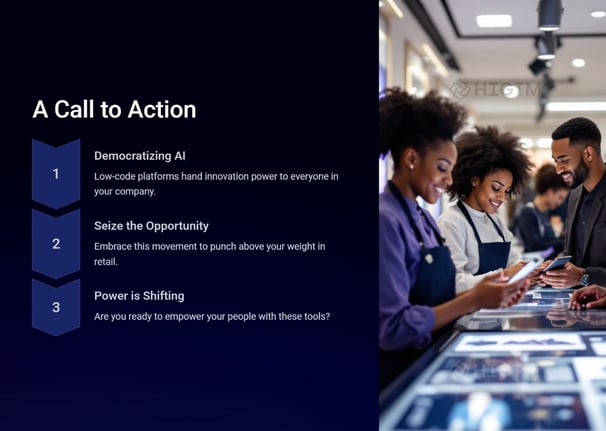

8. Conclusion: Embracing the Future of Retail Innovation
The message is loud and clear: Low-Code/No-Code platforms are democratizing AI development, and retail SMBs stand to gain immensely from this shift. What was once a privilege of the few – the ability to quickly craft intelligent software tailored to one’s business – is now an option for the many. The playing field is being leveled, and the barriers to entry for AI and advanced tech solutions are crumbling.
For decision-makers in the retail sector, the implications are profound. This isn’t just a new tool, it’s a new mindset. It’s about cultivating a culture where anyone with a smart idea can test it out. It’s about moving with a speed and flexibility that bigger organizations might envy. It’s also about resilience – building an organization that can adapt and reconfigure its digital toolkit on the fly as market conditions change or new opportunities arise.
By embracing low-code and no-code development:
You empower your teams to be part of the innovation process, not just the end-users of whatever IT builds.
You reduce dependency on external vendors and hard-to-hire skill sets, which can be a strategic relief in a tight labor market.
You accelerate your digital transformation journey, turning long-term roadmaps into near-term action plans.
In closing, the retail landscape is evolving quickly, and technology will continue to drive that evolution. Small and mid-sized retailers have more agency than ever before to shape their own tech destiny. Those that seize the moment – adopting low-code/no-code platforms to infuse AI and automation into their operations – will find themselves competing at a higher level, punching above their weight class. Those that hesitate may find that the gap between them and the tech-savvy pack only widens.
The playing field is set and the tools are on the table. Innovation has been democratized – it’s up to you to make the most of it. As you consider the next steps, remember that you don’t have to go it alone. Whether it’s tapping into online communities of citizen developers or partnering with consultants who specialize in this domain, support and guidance are available. The key is to start. Start small, start smart, but start now. Your future competitive advantage might just be one drag-and-drop app away.
Ready to dive into low-code/no-code AI development for your retail business? If you need help crafting a strategy or implementing the right solutions, consider reaching out to experts like HIGTM who can guide you through this exciting transformation. As we’ve discussed, the technology is accessible – sometimes a little seasoned advice is all that’s needed to unlock its full potential for your unique challenges and goals. The era of democratized AI development is here; it’s time for SMB retailers to claim their share of the innovation pie.
Turn AI into ROI — Win Faster with HIGTM.
Consult with us to discuss how to manage and grow your business operations with AI.
© 2025 HIGTM. All rights reserved.
